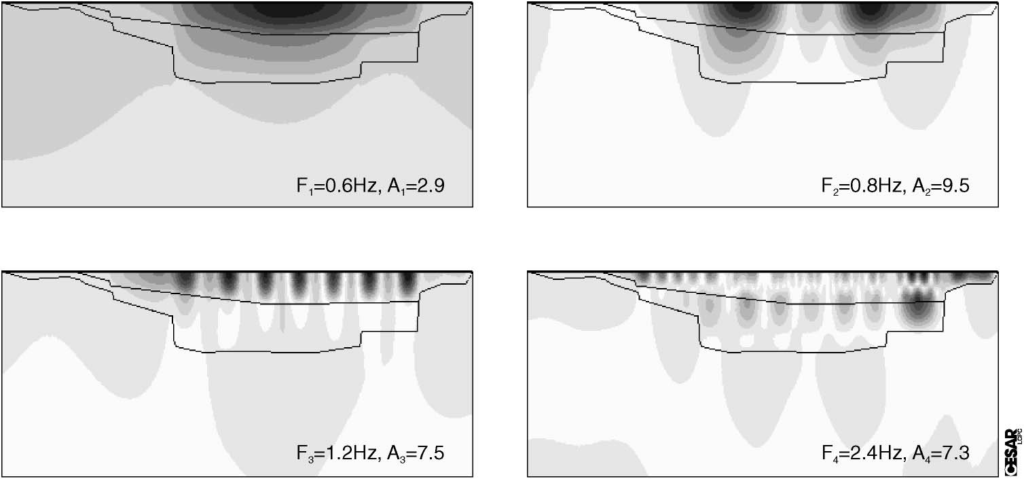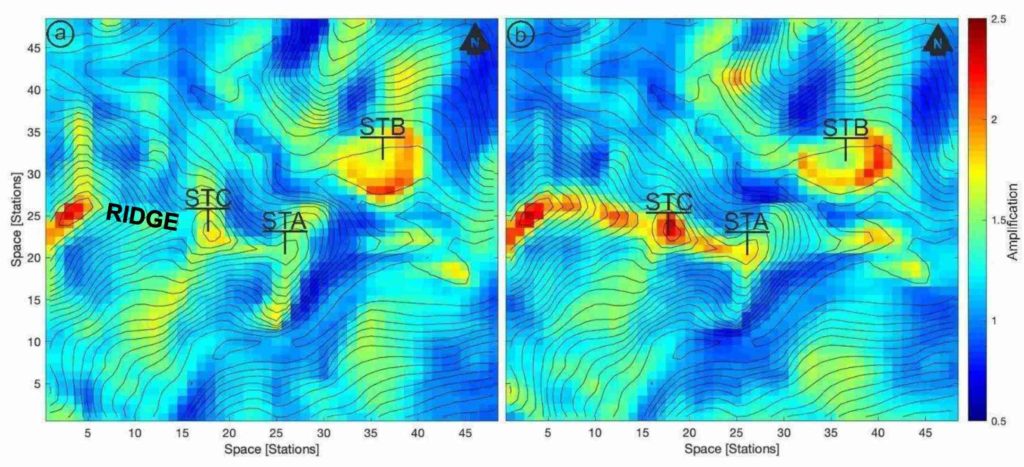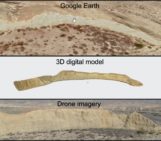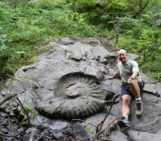
The area were most collapses occurred is a former alluvial outlet for the drainage of water and sediment from the upper parts of the Ahir Mountain
When it comes to earthquakes, the nature of the Earth surface geology and its geometry is critical to understand the intensity and type of motion of the ground where we live. Of course, other factors matter when assessing the risk of damage in human-made structures (e.g., engineering design and materials used). From a sedimentological point of view, it is possible to identify critical elements in the subsurface that we should consider, if we want to foresee areas where human-made structures will receive comparatively high intensity seismic waves. Two major critical elements are: (1) the overall architecture of the subsurface geology, which includes the type of sediment and rock types as well as their dimensions, and (2) the earth surface geometry (i.e., the topography).
An earthquake can be simply defined as the motion of ground by shock waves. There are different causes for shockwaves to be produced in the Earth (read more here). The 2023 southern Turkey Earthquakes were produced by the rupture of two sections associated with the southeastern boundary of the so-called Anatolian tectonic plate. Several areas of the crust in depths lesser than 10 km were torn apart and the shock waves, or also called seismic waves, started to propagate in all directions with velocities in the order of kilometers per second. Seismic waves are not just one type: as the crust pushes rocks and sediments away from the area where the crust just ruptured, two major waves develop: a first wave, called ‘P’ and a second, slower, called ‘S’. When they reach the Earth surface these two fronts interact with it developing the so-called surface waves, the most destructive ones to human-made structures. The physical characteristic of these surface waves change dramatically as they propagate across the Earth surface depending on the two critical elements before mentioned: the subsurface architecture and the topography (read more here).
Those changes in the physical characteristics of waves are usually explained by experts as the ‘non-linear’ behavior of the soil (soil and sediment will be used here interchangeably). In simple terms, the nonlinear behavior of a material refers to a situation where a material does not respond to a force or stress in a predictable way, which is based on what had been happening as the stress would increase. For example, if one applies a relatively small amount of force to a rubber band, it will stretch proportionally to the force applied, and we can record this data as a linear behavior. However, when more force is applied, the rubber band will eventually reach a point where it no longer stretches proportionally to the force applied. The very stress has caused changes in the physical properties of the rubber band so the mathematics that would be used to predict its deformation no longer work. This change in the ratio of force applied and deformation is called as nonlinear behavior. In other words, a material that exhibits nonlinear behavior can behave unexpectedly or unpredictably when subjected to varying levels of stress or force. This can make it challenging to accurately predict what zones in a populated area will suffer a ground motion more damaging than others.
Because of this uncertainty, geoengineers develop modes in computer and laboratory to test different scenarios where seismic waves with different properties propagate through geological models with various types of subsurface architecture and topography (Figure 1).

Figure 1 Seismic wave amplification in the Volvi-EuroSeisTest basin, Greece: BEM simulations at different frequencies Fi and maximum related amplifications (Semblat, 2005, Semblat, 2011).
The illustrated models aim to understand how seismic waves propagate in different configurations of geological structures and thickness of the sedimentary units to the basin ‘bedrock surface’ (the surface of well-lithified rock units where sediments lie). Knowing the depth to bedrock from the ground, is of paramount importance for some experts (e.g., Semblat et al., 2005). There is an agreement that settlements over ‘soft’ sediment-filled valleys or asymmetrical isolated rocky reliefs tend to show more intense surface waves (e.g., Primofiore et al., 2020). But geological and geomorphological factors related to the sedimentological evolution of the landscape have also an impact on the intensity of surface waves: the topography as a key factor that can amplificate ground motion during Earthquakes (Çelebi, 1991; Primofiore et al., 2020).
Italy and Turkey: when sedimentology plays a key role to understand zones with higher risk of damage
From August 2016 to January 2017, a seismic sequence ocurred in the Central Apennines (Italy). During the first shock, two localities close to each other showed intensities with values different enough to investigate the cause(s): the macro-seismic surveys reported an EMS intensity 8-9 at Arquata del Tronto old town sitting along the rocky ridge, while a 7 EMS intensity was recorded at the Borgo hamlet located on the alluvial valley, at the foothill of the rocky ridge (Primofiore et al., 2020). Researchers proposed the hypothesis that differences in topography and subsurface geology could explain the variability in intensity. Numerical models set for different ground motion frequencies would support that hypothesis (Figure 2).

This figure is the result of modelling S-waves in the area of the Arquata del Tronto ridge. Each figure shows results of amplification for ‘components’ of the wave perpendicular one to another. The red colours in the image of the right show relatively high amplification (and damage) with the modelled wave values. Primofiore et al., 2020.
In the city of Kahramanmaraş (Turkey) certain areas of the city had most buildings collapsed during the earthquake on the 6th February, 2023. The area were most collapses occurred is a former alluvial outlet for the drainage of water and sediment from the upper parts of the Ahir Mountain (Figure 3). The sedimentary architecture of alluvial fans would be different enough from the surrounding areas to consider the possibility of this observation as a key factor that may have contributed to the comparatively higher destruction of buildings (see examples of the architecture of alluvial fans here).

The image of the left shows a satellite view of the central part of the city of Kahramanmaraş with an overlay of stretched colours rendered from a Digital Elevation Model (DEM). The DEM clearly shows that the very city centre sits at the outlet of a drainage system of the Ahir Mountain. The image to the right shows a recent satellite view of the city centre where most buildings collapsed.
Retrofitting of buildings according to earthquake hazards is expensive, but, as 2016 earthquakes in Italy demonstrate, governments could use modelling from experts to focus investments in certain areas of cities and towns where retrofitting would be a priority because of comparatively high risk.
Help victims of the earthquakes here: www.ifrc.org
References:
Celebi, M., 1991. Topographical and geological amplification: case studies and engineering implications. Structural Safety, 10(1-3), pp.199-217.
Primofiore, I., Baron, J., Klin, P., Laurenzano, G., Muraro, C., Capotorti, F., Amanti, M. and Vessia, G., 2020. 3D numerical modelling for interpreting topographic effects in rocky hills for Seismic Microzonation: The case study of Arquata del Tronto hamlet. Engineering Geology, 279, p.105868.
Semblat, J.F., Kham, M., Parara, E., Bard, P.Y., Pitilakis, K., Makra, K. and Raptakis, D., 2005. Seismic wave amplification: Basin geometry vs soil layering. Soil dynamics and earthquake engineering, 25(7-10), pp.529-538.
Semblat, J.F., 2011. Modeling seismic wave propagation and amplification in 1D/2D/3D linear and nonlinear unbounded media. International Journal of Geomechanics, 11(6), pp.440-448.




